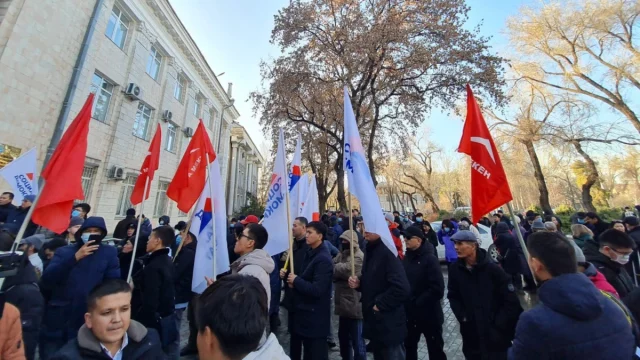
Tajikistan’s Pamir Region Descends Into Chaos
Publication: Eurasia Daily Monitor Volume: 18 Issue: 178
By:

The extrajudicial murder of a local Pamiri activist by state security police in the mountainous and impoverished Gorno-Badakhshan Autonomous Oblast of Tajikistan has sparked violent protests in that region’s capital, Khorog. The mass demonstrations have so far claimed at least three other lives and left numerous protesters and police officers wounded. Tajikistanis living in Russia and the West have staged rallies of their own, demanding that Dushanbe publicly investigate the Gorno-Badakhshan murder and punish those responsible (KNews.kg, November 27; ASIA-Plus, November 30).
To date, the authorities have not used massive force to put down the protests in Khorog—unlike against earlier such marches in 2012, 2014 and 2018 (see EDM, July 24, 2018 and October 18, 2018). Their restraint is likely due to fears that a crackdown could prove counterproductive, exacerbating the anger of the local population, whose demands are increasing with each passing day. At the same time, a violent suppression of the Pamiri protesters might draw in Afghanistan, where the Taliban has seized power; Russia, which has a military base in Tajikistan and a huge Tajik émigré population; or China, which is also building a facility in Gorno-Badakhshan for its security forces.
Dushanbe may apparently not be ready or even able to change course: whether by providing more support for the oblast, restricting the activities of its security police (which treats Gorno-Badakhshan more like an occupied territory than part of the same country), or allowing the population there to run its own affairs. As a result, some analysts are already calling the Khorog clashes the most serious challenge ever to the rule of Emomali Rahmon, who has served as the country’s head of state since 1994. These analysts speculate that outside actors, foremost the Afghan Taliban but also perhaps Russia and China, will put pressure on Rahmon to end the clashes lest they spread and destabilize not just Tajikistan but Central Asia more broadly (Nezavisimaya Gazeta, Vzglyad, November 28; Stan Radar, November 29).
On November 25, Gulbiddin Ziyobekov, who authorities say was involved in criminal activities, was killed while in detention. His family then brought his casket to the main square of Khorog, where they were joined by several thousand others who called for an honest investigation of the case. But with each passing day, the protesters have become more numerous and more radical. They are now demanding the withdrawal of at least 70 percent of the Tajikistani police force from Gorno-Badakhshan and for the ostensibly autonomous region to be truly allowed to run its own affairs. Analysts in both Tajikistan and Moscow argue that the murder was the occasion rather than the true cause of the demonstrations. They say that massive poverty, increasing inflation, water shortages, and the lack of official responses to the needs of the population are the real underlying factors driving the unrest (Moskovsky Komsomolets, Stan Radar, November 29).
Moreover, these analysts say, there is at least one other, even deeper cause, which was further exacerbated in the wake of the Taliban victory in Afghanistan. Many of the residents of Gorno-Badakhshan have close relatives in Afghanistan. They were able to maintain contact with them until the Taliban victory; but Dushanbe, working with Russia, has effectively closed the border. Moreover, most Pamiri Tajiks on both sides of the border are religiously Ismailis and followers of the Aga Khan rather than Sunni Muslims as are most other ethnic Tajiks. Tajikistan’s Pamiris keep in close touch with Ismaili leaders abroad through a religious center in Khorog as well as via Afghan and Iranian television, which most residents of Gorno-Badakhshan can easily access and understand.
These ties have caused many in Dushanbe to assume that they already face a separatist challenge in Gorno-Badakhshan, an area that is home to only about 220,000 people but covers 45 percent of the country. Aleksandr Knyazev, a Moscow-based specialist on Central Asia, says that, for now, “it is not appropriate to speak about separatism there”; however, Dushanbe’s hardline approach is leading to radicalization that may create a self-fulfilling prophecy, especially if the Taliban or others in Afghanistan decide to try to put the region in play (Nezavisimaya Gazeta, November 28).
Knyazev favors involving the Aga Khan in talks with the protesters, something Dushanbe has been reluctant to do; but other analysts argue a much more fundamental shift in approach is necessary. In particular, those voices contend, the central government should provide more money and more autonomy to Gorno-Badakhshan or risk ever more serious problems—as the current wave of protests shows. And Dushanbe must be sensitive to the fact that if it proves incapable of ending the demonstrations quickly, Russia or even China might take action instead (Stan Radar, November 29).
Both Moscow and Beijing have the capacity to act. Russia has long maintained a military base inside Tajikistan; and China has more recently built some sort of military or paramilitary facility in the Central Asian republic’s Pamir mountains, nominally for the Tajikistanis but in fact for itself, in case of a brewing security threat to China. Presumably, were the situation in Gorno-Badakhshan to spin out of control, the two large Eurasian powers would act together, as both have common interests. However, the specter of outsiders using military force to put down protests in Tajikistan would not sit well with many across Central Asia, including those who would, in fact, like the unrest to calm itself lest the Taliban or local Islamist radicals exploit these protests. As a result, it is more likely that Moscow and Beijing will simply put pressure on Rahmon and his government to change course, perhaps providing funding to allow him to do so but threatening other actions if he does not.
Such pressure could inadvertently generate political instability in Dushanbe. Consequently, the current protests in Gorno-Badakhshan are likely, one way or another, to send shockwaves across the country and the wider region as well.



